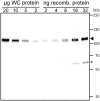CLPB3 is required for the removal of chloroplast protein aggregates and thermotolerance in Chlamydomonas
- PMID: 36951384
- PMCID: PMC10299786
- DOI: 10.1093/jxb/erad109
CLPB3 is required for the removal of chloroplast protein aggregates and thermotolerance in Chlamydomonas
Abstract
In the cytosol of plant cells, heat-induced protein aggregates are resolved by the CASEIN LYTIC PROTEINASE/HEAT SHOCK PROTEIN 100 (CLP/HSP100) chaperone family member HSP101, which is essential for thermotolerance. For the chloroplast family member CLPB3 this is less clear, with controversial reports on its role in conferring thermotolerance. To shed light on this issue, we have characterized two clpb3 mutants in Chlamydomonas reinhardtii. We show that chloroplast CLPB3 is required for resolving heat-induced protein aggregates containing stromal TRIGGER FACTOR (TIG1) and the small heat shock proteins 22E/F (HSP22E/F) in vivo, and for conferring thermotolerance under heat stress. Although CLPB3 accumulation is similar to that of stromal HSP70B under ambient conditions, we observed no prominent constitutive phenotypes. However, we found decreased accumulation of the PLASTID RIBOSOMAL PROTEIN L1 (PRPL1) and increased accumulation of the stromal protease DEG1C in the clpb3 mutants, suggesting that a reduction in chloroplast protein synthesis capacity and an increase in proteolytic capacity may compensate for loss of CLPB3 function. Under ambient conditions, CLPB3 was distributed throughout the chloroplast, but reorganized into stromal foci upon heat stress, which mostly disappeared during recovery. CLPB3 foci were localized next to HSP22E/F, which accumulated largely near the thylakoid membranes. This suggests a possible role for CLPB3 in disentangling protein aggregates from the thylakoid membrane system.
Keywords: Chlamydomonas reinhardtii; DEG protease; HSP100; chloroplast protein homeostasis; molecular chaperones; small heat shock proteins; unfolded protein response.
© The Author(s) 2023. Published by Oxford University Press on behalf of the Society for Experimental Biology.
Conflict of interest statement
The authors have no conflict of interest to declare.
Figures







References
-
- Agarwal M, Sahi C, Katiyar-Agarwal S, Agarwal S, Young T, Gallie DR, Sharma VM, Ganesan K, Grover A.. 2003. Molecular characterization of rice hsp101: complementation of yeast hsp104 mutation by disaggregation of protein granules and differential expression in indica and japonica rice types. Plant Molecular Biology 51, 543–553. - PubMed
-
- Amunts A, Drory O, Nelson N.. 2007. The structure of a plant photosystem I supercomplex at 3.4 A resolution. Nature 447, 58–63. - PubMed
-
- Asamizu E, Miura K, Kucho K, Inoue Y, Fukuzawa H, Ohyama K, Nakamura Y, Tabata S.. 2000. Generation of expressed sequence tags from low-CO2 and high-CO2 adapted cells of Chlamydomonas reinhardtii. DNA Research 7, 305–307. - PubMed
-
- Avellaneda MJ, Franke KB, Sunderlikova V, Bukau B, Mogk A, Tans SJ.. 2020. Processive extrusion of polypeptide loops by a Hsp100 disaggregase. Nature 578, 317–320. - PubMed
-
- Bai C, Guo P, Zhao Q, et al. . 2015. Protomer roles in chloroplast chaperonin assembly and function. Molecular Plant 8, 1478–1492. - PubMed
Publication types
MeSH terms
Substances
LinkOut - more resources
Full Text Sources
Miscellaneous

